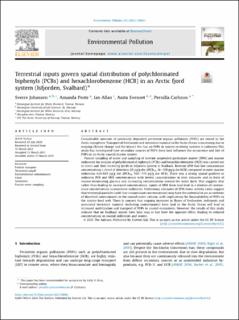| dc.contributor.author | Johansen, Sverre | |
| dc.contributor.author | Poste, Amanda | |
| dc.contributor.author | Allan, Ian | |
| dc.contributor.author | Evenset, Anita | |
| dc.contributor.author | Carlsson, Pernilla Marianne | |
| dc.date.accessioned | 2021-07-14T13:26:23Z | |
| dc.date.available | 2021-07-14T13:26:23Z | |
| dc.date.created | 2021-05-03T20:05:08Z | |
| dc.date.issued | 2021 | |
| dc.identifier.citation | Environmental Pollution (1987). 2021, 281, 116963. | en_US |
| dc.identifier.issn | 0269-7491 | |
| dc.identifier.uri | https://hdl.handle.net/11250/2764444 | |
| dc.description.abstract | Considerable amounts of previously deposited persistent organic pollutants (POPs) are stored in the Arctic cryosphere. Transport of freshwater and terrestrial material to the Arctic Ocean is increasing due to ongoing climate change and the impact this has on POPs in marine receiving systems is unknown This study has investigated how secondary sources of POPs from land influence the occurrence and fate of POPs in an Arctic coastal marine system.
Passive sampling of water and sampling of riverine suspended particulate matter (SPM) and marine sediments for analysis of polychlorinated biphenyls (PCBs) and hexachlorobenzene (HCB) was carried out in rivers and their receiving fjords in Isfjorden system in Svalbard. Riverine SPM had low contaminant concentrations (<level of detection-28 pg/g dw ΣPCB14, 16–100 pg/g dw HCB) compared to outer marine sediments 630-880 pg/g dw ΣPCB14, 530–770 pg/g dw HCB). There was a strong spatial gradient in sediment PCB and HCB concentrations with lowest concentrations in river estuaries and in front of marine-terminating glaciers and increasing concentrations toward the outer fjord. This suggests that rather than leading to increased concentrations, inputs of SPM from land lead to a dilution of contaminant concentrations in nearshore sediments. Preliminary estimates of SPM:water activity ratios suggest that terrestrial particles (with low contaminant concentrations) may have the potential to act as sorbents of dissolved contaminants in the coastal water column, with implications for bioavailability of POPs to the marine food web. There is concern that ongoing increases in fluxes of freshwater, sediments and associated terrestrial material (including contaminants) from land to the Arctic Ocean will lead to increased mobilization and transport of POPs to coastal ecosystems. However, the results of this study indicate that on Svalbard, inputs from land may in fact have the opposite effect, leading to reduced concentrations in coastal sediments and waters. | en_US |
| dc.language.iso | eng | en_US |
| dc.publisher | Elsevier | en_US |
| dc.rights | Navngivelse 4.0 Internasjonal | * |
| dc.rights.uri | http://creativecommons.org/licenses/by/4.0/deed.no | * |
| dc.title | Terrestrial inputs govern spatial distribution of polychlorinated biphenyls (PCBs) and hexachlorobenzene (HCB) in an Arctic fjord system (Isfjorden, Svalbard) | en_US |
| dc.type | Peer reviewed | en_US |
| dc.type | Journal article | en_US |
| dc.description.version | publishedVersion | en_US |
| dc.rights.holder | © 2021 The Authors. | en_US |
| dc.source.pagenumber | 10 | en_US |
| dc.source.volume | 281 | en_US |
| dc.source.journal | Environmental Pollution (1987) | en_US |
| dc.identifier.doi | 10.1016/j.envpol.2021.116963 | |
| dc.identifier.cristin | 1907869 | |
| dc.relation.project | Norges forskningsråd: 268458 | en_US |
| dc.source.articlenumber | 116963 | en_US |
| cristin.ispublished | true | |
| cristin.fulltext | original | |
| cristin.qualitycode | 1 | |

